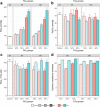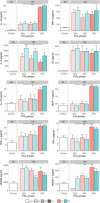Hyperoxia provokes a time- and dose-dependent inflammatory response in mechanically ventilated mice, irrespective of tidal volumes
- PMID: 28550659
- PMCID: PMC5446430
- DOI: 10.1186/s40635-017-0142-5
Hyperoxia provokes a time- and dose-dependent inflammatory response in mechanically ventilated mice, irrespective of tidal volumes
Abstract
Background: Mechanical ventilation and hyperoxia have the potential to independently promote lung injury and inflammation. Our purpose was to study both time- and dose-dependent effects of supplemental oxygen in an experimental model of mechanically ventilated mice.
Methods: Healthy male C57Bl/6J mice, aged 9-10 weeks, were intraperitoneally anesthetized and randomly assigned to the mechanically ventilated group or the control group. In total, 100 mice were tracheotomized and mechanically ventilated for either 8 or 12 h after allocation to different settings for the applied fractions of inspired oxygen (FiO2, 30, 50, or 90%) and tidal volumes (7.5 or 15 ml/kg). After euthanisation arterial blood, bronchoalveolar lavage fluid (BALf) and tissues were collected for analyses.
Results: Mechanical ventilation significantly increased the lung injury score (P < 0.05), mean protein content (P < 0.001), and the mean number of cells (P < 0.01), including neutrophils in BALf (P < 0.001). In mice ventilated for 12 h, a significant increase in TNF-α, IFN-γ, IL-1β, IL-10, and MCP-1 (P < 0.01) was observed with 90% FiO2, whereas IL-6 showed a decreasing trend (P for trend = 0.03) across FiO2 groups. KC, MIP-2, and sRAGE were similar between FiO2 groups. HMGB-1 was significantly higher in BALf of mechanically ventilated mice compared to controls and showed a gradual increase in expression with increasing FiO2. Cytokine and chemokine levels in BALf did not markedly differ between FiO2 groups after 8 h of ventilation. Differences between the tidal volume groups were small and did not appear to significantly interact with the oxygen levels.
Conclusions: We demonstrated a severe vascular leakage and a pro-inflammatory pulmonary response in mechanically ventilated mice, which was enhanced by severe hyperoxia and longer duration of mechanical ventilation. Prolonged ventilation with high oxygen concentrations induced a time-dependent immune response characterized by elevated levels of neutrophils, cytokines, and chemokines in the pulmonary compartment.
Keywords: Hyperoxia; Inflammation; Mechanical ventilation; Oxygen toxicity; VILI; mice.
Figures



References
-
- Helmerhorst HJ, Roos-Blom MJ, van Westerloo DJ, de Jonge E. Association between arterial hyperoxia and outcome in subsets of critical illness: a systematic review, meta-analysis, and meta-regression of cohort studies. Crit Care Med. 2015;43(7):1508–1519. doi: 10.1097/CCM.0000000000000998. - DOI - PubMed
-
- de Jonge E, Peelen L, Keijzers PJ, Joore H, de Lange D, van der Voort PH, Bosman RJ, de Waal RA, Wesselink R, de Keizer NF. Association between administered oxygen, arterial partial oxygen pressure and mortality in mechanically ventilated intensive care unit patients. Crit Care. 2008;12(6):R156. doi: 10.1186/cc7150. - DOI - PMC - PubMed
LinkOut - more resources
Full Text Sources
Other Literature Sources
Miscellaneous

